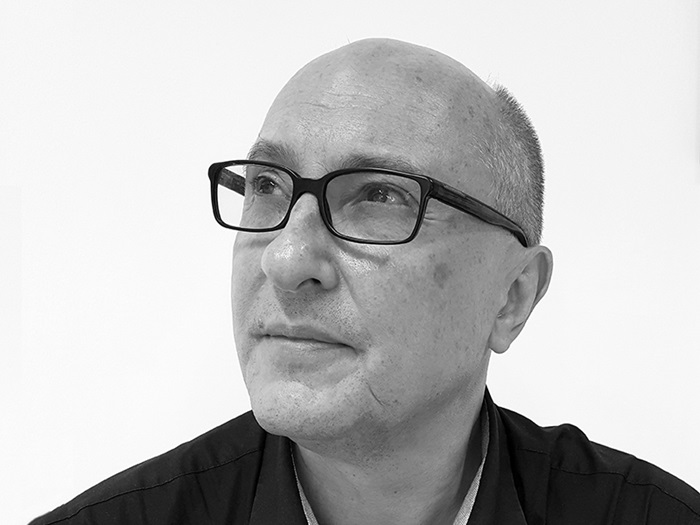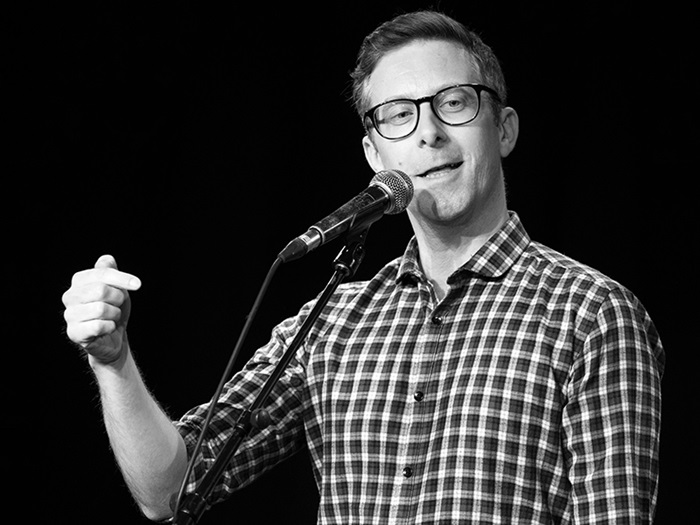Eye-catching infographics, punchy messaging, and clear language are just three ways to grab people’s attention. Laura West, Senior Scientific Excellence Coordinator of R&D Biopharm Discovery at GSK, explains how to make your scientific research more visually attractive.
When it comes to displaying your scientific work, the experiments and data could be your best, but getting the visibility your work deserves and engaging your target audience require careful thought. It is, therefore, vital to be to think about how you communicate, not just what you communicate.
Every day, we are inundated with information. It’s more important now than ever to grab the attention of your audience, while improving the way you communicate. This helps people retain information about the data and key messages you deliver.
Ask yourself: what is the key message I want people to take away from this piece of work? You can then start to build around that.
When it comes to the overall layout of your work, you need to think about visual hierarchy, which is the arrangement of the elements on the page. This tells readers what to focus on depending on its importance.
It’s also worth thinking about how people best consume their media. Infographics, data visualisation graphs, images, and short videos are all great ways to attract and hold people’s attention.
Here are five ways to boost engagement in your work today.
1. Start with a bold, catchy message
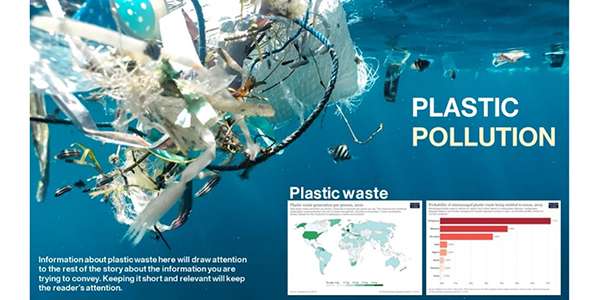
Image from Naja Bertolt Jensen, Data: Plastic Pollution - Our World in Data. Graphic from Laura West
A clear, simple message that is big, bright, bold and catchy will grab people’s attention. Take a look at the infographic below. Notice how your eyes are immediately drawn to ‘Plastic Pollution’, which is short, punchy, and immediately noticeable.
2. Pick relevant images

65% of people recall information for up to three days when it is paired with a relevant image. So, pick relatable images to make your work more memorable.
3. Keep it simple
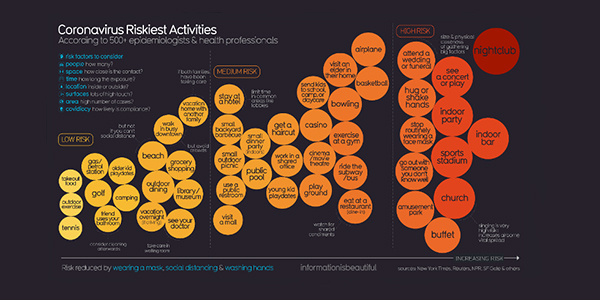
Covid 19 Infographic Datapack from Information is Beautiful.
Aim to keep your sentences short and use simplified language. This approach will make your work more accessible and easier to understand, and it will help your audience retain information.
Second, if you have a large amount of data, consider how to display it so that people can immediately follow what you’re showing them.
Take a look at the ‘Coronavirus Riskiest Activities’ infographic below. You can immediately see that ‘nightclub’ is the riskiest activity from the huge amount of information on the page. Note the use of negative space (or empty space) on the page to intensify the size of each bubble.
4. Use colour and contrast
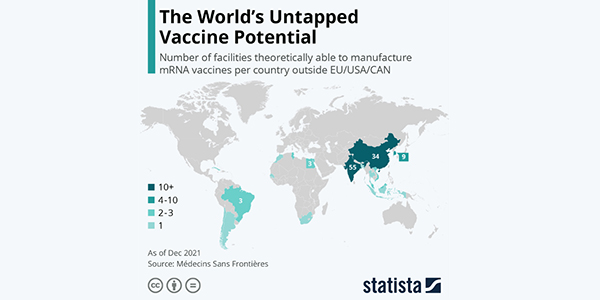
This infographic from Statista uses a simple colour scale to clearly demonstrate the data.
Colour choice matters. Our eyes pick up the contrast between certain colours and using this to your advantage will help accentuate the importance of certain items on the page. Think about the contrast between the colours you are displaying to make the text or imagery striking. This helps readers associate patterns or trends quickly.
In the image above, for example, it is easy to identify the teal colours against the white background and grey world map and immediately identify the countries.
5. Think about how people read
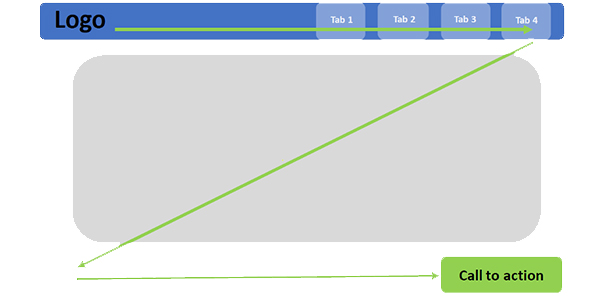
Readers use a 'Z' pattern to visually skim content.
Studies show that when we ingest digital information, we first scan the page in a ‘Z’ or ‘F’ pattern to determine whether it is worth reading.
If the information is predominantly text heavy, we read by scanning the left side of the page as this contains left aligned headings and bullet points. When reading information that is not in text-heavy paragraphs, we tend to read in the more ‘Z’ aligned format (left to right and top to bottom).
When thinking about the type of work you are displaying, consider where you want your most important information on the page.
Suze Kundu’s career has taken her from nanochemistry to science communication and even to presenting TV shows on the Discovery Channel. So, how did she go from academic to Head of Public Engagement at Digital Science, and what advice does she have for those looking to follow in her footsteps?
You’ve had a really varied career path. How did you get to where you are today?
Varied indeed! I categorise my career into two strands – doing science, and communicating science. And I’ve done both alongside one another for over a decade now. The former UK Chief Science Officer, Professor Sir Mark Wolport, once said that science isn’t finished until it is communicated. This is something that my alma mater, UCL (University College London) not only believes, but also supports.
Given that research is largely publicly funded, researchers owe it to the public to communicate progress and outputs. By creating opportunities for dialogue, this communication becomes a two-way process, which also benefits researchers who can conduct better-informed research that will help more of society.
As such, I was trained in being both a researcher as well as a public engagement practitioner during my undergraduate degree and during my PhD. I’ve been really lucky to have been able to keep both strands of my career running either concurrently or in combined roles. When I was an academic, I would do research, teaching and public engagement as part of my varied day job, and I also kept up with my science writing and TV presenting in my spare time. I now work at Digital Science, which is a research technology company that creates mostly software solutions for different aspects of the research cycle to help it be the best it can be.
At Digital Science, I headed up Engagement for three years, before recently moving on to a role that combines my engagement skills with my chemistry knowledge and my unashamed fangirling over our flagship platform, Dimensions, to support our newest addition to the family: Dimensions Life Science and Chemistry.
All of our software solutions are created with the research community in mind, and are often developed and refined in collaboration with actual users, so we know that our tools can help people overcome research challenges.
What personal challenges have you faced and how have you overcome them?
Thanks to my parents, my school and my university, I grew up fairly sheltered from a range of ‘-isms’ that may have resulted in my being put off a career in science. Being a woman, a woman of colour, and a woman who perhaps doesn’t conform to outdated stereotypes of what ‘scientists’ are like are all things I learnt can be hurdles to overcome in my career.
In many ways, I was glad that I had no idea that academia, for example, was such a challenging environment for underrepresented people, as I am not sure I would have pursued a career in it if I had known. Women in academia are often assigned teaching that covers the basics, and are frequently given tasks that require so-called ‘softer’ skills such as outreach, engagement and the admissions process. In a world where women have to work twice as hard to get half the recognition, this can often lead to burnout.
I did two things to overcome these challenges once I had identified them; firstly, I had some great allies that came to my aid. They helped me objectively highlight the inconsistencies in workload and expectations, and they were always on hand to offer advice to help me overcome hurdles. Secondly, I chose to leave academia for industry. I now work in an organisation where all the diverse facets that make up an individual are respected and welcomed.
My advice would be that, if you think a science career isn’t for you, you may not have found ‘your people’ yet. I assure you, though, that scientific careers are so much broader than just academia and traditional industry roles. Keep looking and use your networks to find your type of organisation, as I can guarantee that they’re out there somewhere.
Suze Kundu
You’re very skilled at communicating complicated topics to non-specialist audiences. How do you do it?
I was lucky enough to attend UCL for my undergraduate and PhD. UCL has a long history of engagement with a range of communities. It is thanks to opportunities I had during my degrees there that I started to really hone my communication skills.
Strangely enough, I think my acting, drama, dance and musical theatre skills have also played a part in building my skills, as there is always an element of performance in everything that we do. You need to know your audience, and know what motivates them, to really engage with them.
I do believe that everyone can learn and develop communication skills though. I’m not saying everyone needs to present evidence in a parliamentary inquest. There are so many different ways to communicate research, whether it is through writing, drawing, even music and dance.
It could even be as simple as just engaging with your PR team to find support in sharing your research more broadly. It’s a really collaborative space though, so if you want to give it a go or learn more, find some people whose communications style you like and get in touch. If they’ve got the capacity I’m sure they will either be able to help, or at least point you in the right direction.
Which mentors have helped you along the way?
Firstly, my parents, who made me believe that I could pursue anything I wanted to and they’ve been nothing but supportive. My husband is also totally wonderful, even though he wishes I worked more sensible hours. Secondly, I have a set of amazing friends that remind me that I can do things, even when I doubt myself.
Finally, there are some amazing heroes-turned-allies out there that have supported me along the way. My top four would be my ever-supportive PhD supervisor Professor Ivan Parkin at UCL, my old chemistry teacher Mr Brian McVicar, my science communication hero Professor Mark Miodownik at UCL, and my academic role model Professor Mary Ryan at Imperial College London. Our CEO at Digital Science, Dr Daniel Hook, is also an inspiration and an example of having both a career in enterprise and leadership, AND a career in academia.
>> Read about Dr Anita Shukla’s groundbreaking work in treating infection and developing drug delivery systems in our interview with Dr Shukla.
What is the current state of play within your sector with respect to equality, diversity, and inclusion – and is enough being done to attract and retain diverse talent?
In academia, my experiences have not been great. We spend a lot of time, money and effort recruiting a more diverse range of people into science degrees but very little time retaining those people in the profession.
Though things are improving, changing an entire culture is slow going, and I think academia is still fundamentally built on a framework that rewards and promotes cultures and behaviours that do not allow for inclusion.
We have a long way to go to breaking down those barriers to inclusion. We’ve worked with a range of actors in the research industry through the Research on Research Institution (RoRI), but culture change takes time. It requires buy-in at all levels and globally across the profession, as well as a lot of resource to build a better framework of recognition and reward to encourage inclusion and retention within the academic profession.
In industry, I think we are in a much better place in terms of equality, diversity, inclusion and accessibility, though there are of course still challenges that need to be overcome. Organisations have more control over how they nurture their employee communities, and I think it can therefore be easier to see changes in culture sooner than in academia.
There is still a long way to go to make things as inclusive as they can be, and to achieve real representation of society in industry, but by working with underrepresented communities we are able to co-create initiatives that will hopefully change things for the better.
Is there any advice you would give to young professionals looking to pursue a career path similar to yours, especially young women?
Do it! Science is such a rewarding profession, and so varied too. You’re able to combine your passion for science with your interest in a whole host of things. Do, however, be aware that you may not immediately find an environment that can support and nurture you in a way that works for you. They are out there though, so keep networking, keep looking, and be your truest self. You’ll find your people soon enough, and from there on in, it’s a great adventure.
Don’t be afraid to try things. You may well surprise yourself and start a career journey down a path you didn’t expect to find yourself on. And remember, no experience is wasted. Your skillset is always building up, and you’ll find yourself applying experiences and knowledge in ways you never expected you would.
Find a mentor or a range of mentors for different aspects of your career, and consider being a mentor for others too. You have a remarkable amount of knowledge and experience to share with others too.
>> In recent months, we’ve spoken to inspiring women who work in science. Read more about the stories of materials scientist Rhys Archer, EPSRC Doctoral Prize Fellow and founder of Women of Science, and Jessica Jones, Applications Team Leader at Croda.
Edited by Eoin Redahan. You can find more of his work here.
How do you get large audiences to read about your work? Roger Highfield, Science Director of the Science Museum, and Steve Scott, Public Engagement Lead of UK Research and Innovation, shared their insights at a recent webinar organised by SCI.
‘When I talk to people about science writing – when I’m talking about the introduction – I ask them to practise on a long-suffering friend and read a couple of paragraphs of what they’ve written. If they reach for their phone, you’ve done something wrong.’
Some people’s observations should be taken with a liberal fistful of salt, but Roger Highfield is certainly worth listening to when it comes to connecting with the public. As Science Director of the Science Museum Group, he helped engage with more than five million visitors in 2019/20 alone and has written and edited thousands of articles as Science Editor of the Daily Telegraph and Editor of New Scientist.
Roger Highfield, Science Director of the Science Museum
So, how can you reach large audiences with scientific content? First of all, salience is important. How does what you’re talking about have a material effect on people’s lives? As Roger Highfield noted dryly: ‘People will be very interested in asteroids when one’s bearing down on the Earth.’
Citizen science and the long form Q&A
Similarly, the public has been voracious in its consumption of Covid-19-related content despite the complicated nature of the virus and vaccine development. During lockdown, Roger Highfield’s long form Q&A blogs about Covid-19 were hugely popular because, as he said, ‘there was a public appetite for a deeper dive into the science’.
Aside from writing in a way that decongests heavy, complicated subjects, it also helps to get your research in front of the right people, namely communications specialists. ‘One lesson for mass engagement is to work with media organisations,’ he added. ‘It’s more than a platform – you’re dealing with experts in public engagement.’
For larger organisations, citizen science is an excellent way to engage people by making them part of a project. The Great Backyard Bird Count is a fine example of citizen science at its simple, effective best, with thousands of bird-watchers helping provide a real-time snapshot of bird populations around the world.
Highfield has engaged with the public in all manner of citizen science initiatives, from recent online cognition tests in which 110,000 people took part, all the way back to an experiment asking people about the catchiest song in the world. ‘At the time, it was The Spice Girls’ Wannabe,’ he said. ‘People recognised it in 2.5 seconds.’
At its best, citizen science doesn’t just help you to engage people in your work; it can be used as a valuable way to gather information and provide unique perspectives. ‘Citizen science is not just a flash in the pan. The role is changing,’ said Steve Scott, Public Engagement Lead at UK Research and Innovation (UKRI). ‘It’s an effective way of gaining knowledge… bringing different forms of knowledge and expertise into research.’
Steve Scott, Public Engagement Lead of UK Research and Innovation
Scott used the University of West London-led Homes Under the Microscope project to illustrate his point. As part of this project, people in Bristol and Bradford will detect and monitor airborne microplastic sources in their homes and feed this information back to the project organisers to help assess the prevalence of these substances.
A cultural shift
If you’d like more people to read about your research or product, it’s also worth thinking about the way people consume media. According to Scott, the general public tends to consume science through televisions and museums (for example, a visit to the zoo), and people are most likely to follow up on scientific matters having seen them on the news.
Many people learn about science through social media and YouTube, but other vehicles are worth considering too if you want to raise awareness. The UKRI views gaming as a significantly untapped area of public engagement and is investing in this area. Another intriguing way to raise awareness of innovative research is through awards, with the recent, well publicised Earthshot Awards providing a case in point. ‘They’ve taken research grants,’ Scott said, ‘and made them into the Oscars.’
Encouragingly, as the means of communication are changing, so too is the readiness of researchers to share their work. Both Highfield and Scott have seen a large shift over the past 15 years or so, with more and more scientists communicating their research. ‘It’s recognised as being an important part of being a researcher now,’ Scott said. ‘You’re excited about [your research]… Why would you not talk to the public about it?
The big takeaway
So, what is the most important takeaway from the talks, apart from that all-important Spice Girls fact? Fundamentally, when you are communicating your research or peddling your company’s wares, it helps to narrow your focus.
Indeed, Scott reminded us that the public is not a homogeneous group. ‘If we want to engage with millions of people, we need to think of audiences as more than just the general public,’ he said.
He said that 75 per cent of the potential UK audience – roughly 49 million people – falls into one of two groups: they don’t think science is for them, or they’re inactive. So, it’s worth taking an in-depth look at your target demographic and the places it goes to for news before sharing your work.
Earlier, Roger Highfield emphasised the same thing. He said: ‘If there’s one thing I want you to take from this talk, it’s to think about the audience.’
>> Watch How to engage with millions of people in full on our YouTube channel at: https://youtu.be/HSOMQd958EQ









